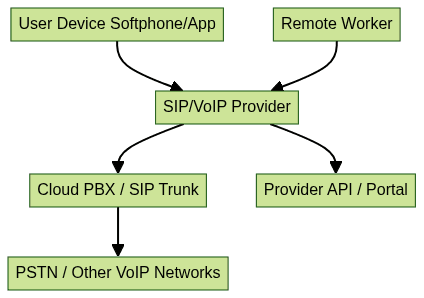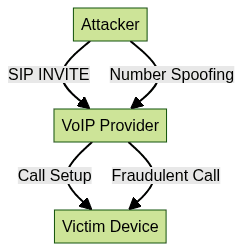Non-Fixed VoIP: The Ultimate Guide for Businesses and Individuals (2025)
Introduction to Non-Fixed VoIP
Non-fixed VoIP (Voice over Internet Protocol) is transforming modern communications by offering flexible, internet-based phone numbers that are not tied to a physical address. Unlike traditional phone lines or fixed VoIP numbers, non-fixed VoIP numbers can be provisioned instantly and used from anywhere with an internet connection. This has huge implications for developers, IT teams, and businesses who need scalable, agile communication solutions. As cloud telephony, remote work, and global operations become the norm in 2025, understanding non-fixed VoIP is crucial for software engineers, IT architects, and business leaders building modern communication stacks.
What is Non-Fixed VoIP?
Non-fixed VoIP refers to virtual phone numbers that are not associated with a specific geographic location or physical infrastructure. These numbers are allocated by VoIP service providers and can be linked to any device—laptop, smartphone, softphone client, or SIP-enabled hardware—via the internet. Unlike fixed VoIP, which typically requires registration with a known address (e.g., for 911 emergency compliance), non-fixed VoIP numbers are location-independent.
For developers looking to integrate calling features into their apps, leveraging a
phone call api
can streamline the process of managing non-fixed VoIP numbers and enhance programmability.Key Characteristics:
- Portability: Numbers can move with the user or organization globally.
- Device Agnostic: Use the same number on multiple endpoints (desktop, mobile, IP desk phone).
- Instant Provisioning: Numbers are created and managed via API or provider portals without physical installation.
Differences from Fixed VoIP and Traditional Telephony
- Fixed VoIP: Tied to a physical address (e.g., business office), often for regulatory or emergency service reasons.
- Traditional Telephony: Requires copper or fiber lines, tied to physical locations, and often expensive to scale.
If you're building a custom calling experience on iOS, following a
callkit tutorial
can help you implement native call UI and manage VoIP calls efficiently.Example Use Cases
- Startups onboarding remote staff worldwide.
- Developers integrating programmable telephony (Twilio, Plivo) for SMS/call features.
- Call centers supporting international customers.
For React Native developers, using
react native callkeep
is a popular approach to handle incoming and outgoing VoIP calls with native call screen integration.Non-Fixed VoIP vs. Fixed VoIP
Below is a technical comparison between non-fixed and fixed VoIP:
1| Feature | Non-Fixed VoIP | Fixed VoIP |
2|------------------------|------------------------------|-------------------------------|
3| Location Binding | Not tied to physical address | Bound to a physical address |
4| Provisioning Speed | Instant/Online | Slower, may require setup |
5| Device Flexibility | High; any SIP device | Usually at a specific site |
6| E911 Compliance | Limited | Strong |
7| Portability | Global | Often local/regional |
8| Regulatory Oversight | Lower | Higher |
9| Use Case | Remote, global, mobile | Office-based, local presence |
101
2For businesses aiming to add both voice and video capabilities, integrating a [Video Calling API](https://www.videosdk.live/audio-video-conferencing) can provide unified communications across platforms.
3
4### Pros and Cons
5**Non-Fixed VoIP Pros:**
6- Maximum flexibility and reach.
7- Rapid, API-driven provisioning.
8- Ideal for distributed/remote teams.
9
10**Cons:**
11- Greater risk of misuse (spam, fraud).
12- Limited emergency service support.
13
14**Fixed VoIP Pros:**
15- Better regulatory compliance.
16- More reliable for local emergency services.
17
18**Cons:**
19- Less portable and scalable.
20- Physical infrastructure often required.
21
22### When To Use
23- Use **non-fixed VoIP** for global, mobile, or rapidly scaling operations.
24- Use **fixed VoIP** for compliance-heavy, location-specific deployments.
25
26## How Non-Fixed VoIP Works
27
28Non-fixed VoIP leverages cloud infrastructure, SIP trunking, and virtual PBX systems to route calls over the internet. Here's a high-level technical overview:
29
30
31
32For developers seeking to build advanced audio features, a robust [Voice SDK](https://www.videosdk.live/live-audio-rooms) can accelerate the creation of scalable, real-time voice applications.
33
34### SIP Trunking & Cloud PBX
35- **SIP Trunking:** Connects VoIP calls to the PSTN (Public Switched Telephone Network) for inbound/outbound calling.
36- **Cloud PBX:** Replaces traditional PBX hardware, offering call routing, voicemail, IVR, and more.
37
38### Device Flexibility & Mobility
39- Users connect from any internet-enabled device.
40- Great for remote work and hybrid offices: the same number works from home, office, or on the road.
41
42If you want to learn how to integrate native calling experiences, check out a comprehensive [callkit tutorial](https://www.videosdk.live/blog/voip-call-app-with-callkit-on-ios) for step-by-step guidance.
43
44## Benefits and Risks of Non-Fixed VoIP
45
46### Key Benefits
47- **Cost Efficiency:** No need for physical lines or on-premise hardware.
48- **Instant Scalability:** Provision or retire numbers quickly.
49- **Global Reach:** Support users or customers anywhere.
50- **API/Programmable:** Integrate telephony into business apps.
51
52To quickly add calling features to your applications, consider using a [phone call api](https://www.videosdk.live/blog/10-best-audio-calling-api) that supports both non-fixed VoIP and traditional telephony.
53
54### Main Risks
55- **Security:** Higher risk of exploitation (e.g., spam, robocalls, number spoofing).
56- **Regulatory/Compliance:** May lack support for emergency services (E911), making legal compliance complex.
57- **Traceability:** Harder to trace malicious actors using non-fixed numbers.
58
59**Summary Points:**
60- \- Cost savings
61- \- Flexibility and portability
62- \- Increased security risks
63- \- Regulatory challenges
64
65## Non-Fixed VoIP Security and Fraud Prevention
66
67Non-fixed VoIP introduces unique security challenges, especially in 2025 as voice spam and phishing attacks rise.
68
69
70
71For those building secure, real-time voice apps, leveraging a [Voice SDK](https://www.videosdk.live/live-audio-rooms) with built-in encryption and authentication features can help mitigate many common threats.
72
73### Common Security Threats
74- **Caller ID Spoofing:** Attackers disguise their identity using programmable VoIP.
75- **Spam & Robocalls:** Automated dialing for scams or marketing.
76- **Account Takeover:** Weak credentials or unpatched software leads to abuse.
77
78### Security Best Practices
79- **Strong Authentication:** Use two-factor authentication for admin portals and APIs.
80- **IP Whitelisting:** Restrict access to SIP endpoints.
81- **Encryption:** Implement SRTP (Secure Real-time Transport Protocol) for call media.
82- **Monitoring & Alerts:** Use call analytics and anomaly detection.
83
84If you're developing for iOS, following a [callkit tutorial](https://www.videosdk.live/blog/voip-call-app-with-callkit-on-ios) can help you implement secure and user-friendly call interfaces.
85
86### Regulatory & Compliance
87- Providers and enterprises must follow regulations like STIR/SHAKEN (for caller ID authentication) and GDPR (for user data protection), especially when deploying non-fixed VoIP globally.
88
89## Use Cases: Non-Fixed VoIP in Business and Beyond
90
91Non-fixed VoIP powers a wide range of modern applications:
92
93- **Call Centers:** Support remote agents on global teams; scale up or down easily.
94- **Remote/Hybrid Work:** Employees stay reachable anywhere.
95- **International Startups:** Instantly provide local numbers in multiple countries.
96- **Unified Communications:** Integrate voice, video, and chat via APIs.
97- **Personal Use:** Private, disposable numbers for privacy or temporary projects.
98
99For cross-platform mobile apps, integrating [react native callkeep](https://www.videosdk.live/blog/react-native-android-video-calling-app-with-callkeep) ensures seamless call handling and notification support.
100
101### Case Study Vignette
102A SaaS startup in 2025 launches a remote-first support center using non-fixed VoIP numbers from a cloud provider. Within days, they onboard agents across three continents. Integration with CRM and ticketing platforms boosts efficiency, and real-time call analytics help block fraudulent calls before they reach users.
103
104## How to Detect and Block Non-Fixed VoIP Numbers
105
106### Detection Techniques
107- **Regex Patterns:** Identify non-fixed VoIP number ranges using known provider prefixes.
108- **API Lookup:** Services like Twilio Lookup or NumVerify reveal number type and provider.
109
110For developers building detection tools, referencing a [callkit tutorial](https://www.videosdk.live/blog/voip-call-app-with-callkit-on-ios) can offer insights into handling VoIP number identification and call management on iOS.
111
112python
import requests
def is_non_fixed_voip(phone_number):
api_key = "YOUR_API_KEY"
url = f"
https://api.numverify.com/v2/validate?number={phone_number}&apikey={api_key}
" response = requests.get(url) data = response.json() return data.get("line_type") == "non_fixed_voip" ```Blocking Strategies
- Blacklist non-fixed VoIP prefixes or numbers via PBX rules.
- Use real-time call filtering tools and APIs.
- Integrate with spam detection databases.
Tools & Services
- Twilio Lookup, NumVerify, Truecaller, Hiya, Spamhaus
- Cloud PBX policies and custom SIP rules
Implementation: Setting Up Non-Fixed VoIP
Provider Selection
- Choose a reputable provider (e.g., Twilio, Plivo, Vonage) with strong API support and compliance features.
If you're ready to get started,
Try it for free
and explore the possibilities of non-fixed VoIP for your business or app.Configuration Steps
- Provision numbers via the provider portal or API.
- Configure SIP endpoints or softphone clients.
- Set up call routing, IVR, and voicemail in the cloud PBX.
Integration
- Use REST APIs or SDKs to connect VoIP with CRM, ticketing, or collaboration tools.
- Document endpoint security and disaster recovery procedures.
Future Trends in Non-Fixed VoIP
- AI & Automation: Smart call routing, speech analytics, and fraud detection powered by machine learning.
- Remote & Hybrid Work: Non-fixed VoIP as the backbone of distributed teams.
- Regulations: Tighter controls on caller ID authentication (STIR/SHAKEN) and cross-border compliance.
Conclusion
Non-fixed VoIP offers unmatched flexibility, scalability, and integration potential for modern businesses and developers. As communications move to the cloud in 2025, understanding and securing non-fixed VoIP is essential for agility and growth.
Want to level-up your learning? Subscribe now
Subscribe to our newsletter for more tech based insights
FAQ